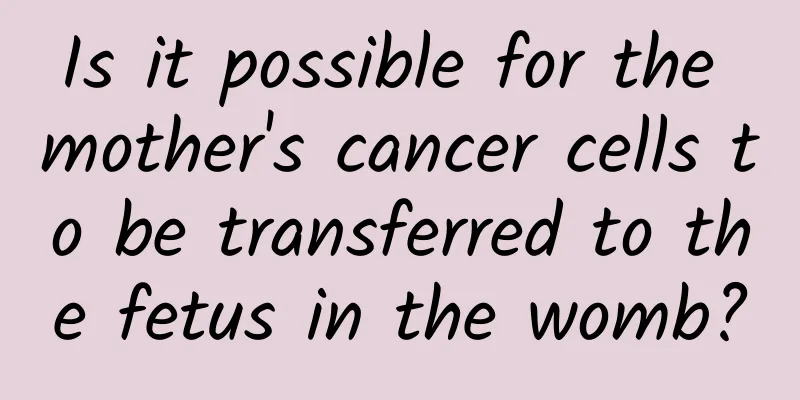Is it possible for the mother's cancer cells to be transferred to the fetus in the womb?

|
Scientists have discovered an extremely rare mechanism by which a mother's cervical cancer cells may be transferred to her unborn baby. From the Internet Author: Gu Shuchen Institute of Life Sciences, Zhejiang University Cancer is known as the king of all diseases, and "cancer cell metastasis" is even more terrifying. Wildly growing cancer cells metastasize from one part of the body to another. But in an extreme case, the unborn fetus is part of the mother's body. Will the mother's cancer cells be transferred to the fetus? Normally, the probability is extremely small. According to statistics, although one in every 1,000 pregnant women has cancer, it is extremely rare for a mother with cancer to pass the cancer to her baby, with an incidence of only about one in half a million. Cancer is traditionally transmitted from mother to child through the blood. However, the National Cancer Research Center of Japan recently discovered that the mother's cancer cells can be passed to the baby in an unexpected way: in two special cases, the mothers who were unaware that they had cervical cancer had cancer cells shed and contaminated the vaginal fluid during childbirth. As a result, the baby happened to inhale the cancer cells into the lungs during the birth canal and unfortunately developed lung cancer. This is the first time in the world that mother-to-child transmission of cervical cancer has been observed, challenging the traditional concept of mother-to-child transmission of cancer. The relevant research was published in the New England Journal of Medicine on January 7. Cancer, the “king of all diseases” There are tens of trillions of cells in the human body, which is more than the number of observable stars in the universe. Every moment, cells in the body divide and replicate regularly to replace aging cells and can also differentiate into other types of cells. However, when cancer appears, this normal process is disrupted. Cancer cells can grow uncontrollably and indefinitely, evade the body's regulation, and escape to various parts of the body, destroying normal organ structures, causing body dysfunction, and thus threatening life. Cancer is often the result of cumulative genetic mutations. | NIH Once cancer occurs, cells seem to have superpowers. They can ignore the body's instructions to stop dividing or die normally and grow indefinitely; they can evade the immune system's supervision, and even cause some immune cells to turn against the body and help them metastasize; they may also induce the surrounding normal cells to form blood vessels, providing cancer cells with oxygen and nutrients needed for growth, and removing metabolic waste. In this way, cancer gradually wears down the human body until death. In severe cases of cancer, cancer cells will spread from the place where they first appeared to various parts of the body like fallen seeds from weeds, taking root and growing, and spreading new tumors. There are usually three ways for cancer to metastasize in the body. One is lymphatic metastasis, where cancer cells metastasize to lymph nodes through lymphatic vessels. Another is hematogenous metastasis, where cancer cells that enter blood vessels travel with the blood to other parts of the body, such as the lungs, brain, liver, and bones. Another is implantation metastasis, where cancer cells fall off the surface of the tumor and fall into the chest cavity, abdominal cavity, and cerebrospinal cavity, where they take root and sprout. However, the process of cancer cell metastasis is not smooth, it also needs to go through many stages: in addition to multiple mutations, movement and massive proliferation, it also needs to secrete special enzymes to penetrate the blood vessels, and even when it enters the blood, it must always guard against all-round attacks by immune cells. Therefore, very few cancer cells can metastasize to other parts of the body. Rare mother-to-child transmission Cancer can spread from one part of the body to another, and in some extreme cases, the unborn fetus, as a part of the mother's body, may also be invaded by the mother's cancer cells. As early as 2009, the Proceedings of the National Academy of Sciences of the United States reported a case of cancer transfer between mother and baby. At that time, a 28-year-old pregnant woman was diagnosed with blood cancer after giving birth and died a few weeks later. Her daughter was also diagnosed with the same cancer when she was 11 months old. Blood tests showed that the cancer cells were transferred to the baby girl through the blood and the mother's placenta. Traditional biological theory holds that even if the mother's cancer cells can cross the natural barrier of the placenta, the fetus's immune system will block them and kill them as foreign bodies. So how do the mother's cancer cells survive in the baby's body? Further investigation revealed that a genetic mutation had occurred in the baby's cancer cells, which made them seem to be wearing an invisibility cloak, and the immune system could not identify them as invaders. As a result, the baby unfortunately inherited the mother's cancer cells. This case is extremely unusual and shows that cancer cells can invade babies' bodies and cause lesions only by bypassing their immune systems. The baby's immune system usually kills the mother's cancer cells, preventing mother-to-child transmission. | peterschreiber.media/Shutterstock.com Two recent cases have further broadened our understanding of the ways cancer is transmitted from mother to child. The mother's cervical cancer turns into the child's lung cancer, and even the type has changed. So how did scientists prove that the two are indeed related? There are three main pieces of evidence: More importantly, the cancers of both children were located in the respiratory tract and spread only along the bronchi in the lungs, unlike the bloodstream, where the lesions may be spread all over the body. All this evidence supports the researchers’ inference of birth canal transmission. Fortunately, although the cancer cells managed to escape the infants' immune system, the symptoms were not as severe as those of normal cancers. One of the infants had spontaneous regression of the lesions without any treatment, while the other infant's disease progressed slowly, with no clinical symptoms until the age of 6. Scientists believe that this is probably because their bodies still initiate allogeneic immune rejection, thereby limiting the development of cancer. This also shows that such mother-to-child transmission events are extremely rare. Active prevention reduces cancer risk Although this report is an accident with extremely low probability, it also reminds us that we should actively prevent cancer. Unlike bacteria and viruses, cancer cells have little ability to survive in the environment and die quickly after leaving the human body, so they are not contagious. Even if a small number of cancer cells enter another person's body, they will cause a strong rejection reaction and will be quickly eliminated by the immune system. However, many types of cancer are caused by bacterial and viral infections. For example, 99.7% of cervical cancer is caused by infection with HPV virus. In addition, Helicobacter pylori may cause gastric cancer, and hepatitis B and hepatitis C viruses may cause liver cancer... Therefore, for ordinary people, reasonable preventive measures can be taken to avoid the occurrence of cancer as much as possible. For example, HPV vaccination can effectively prevent cervical cancer. In addition, regular screening is also an effective means to nip cancer in the bud. Editor | Chen Tianzhen Editor | Gao Peiwen References: [1] Arakawa A, et al. Vaginal Transmission of Cancer from Mothers with Cervical Cancer to Infants. N Engl J Med. 2021 Jan 7;384(1):42-50.[2] Keiko Maruko et al. 10.1016/j.ajog.2003.12.036.[3] Mel Greaves, William Hughes. Cancer cell transmission via the placenta. Evolution, Medicine, and Public Health, Volume 2018, Issue 1, 2018, Pages 106–115, https://doi.org/10.1093/emph/eoy011[4] JM Walboomers et al. Human papillomavirus is a necessary cause of invasive cervical cancer worldwide. 1999 Sep;189(1):12-9. doi: 10.1002/(SICI)1096-9896(199909)189:13.0.CO;2-F.[5] Isoda T, et al. Immunologically silent cancer clone transmission from mother to offspring. Proc Natl Acad Sci US A. 2009 Oct 20;106(42):17882-5. The article was published by the public account "Ten Points Science" (ID: Science_10). Please indicate the source when reprinting. |
<<: How to drive in the rain? What should you pay attention to when driving in heavy rain?
>>: Foreign surrogacy leads to tragedy, is it feasible if the eggs are frozen?
Recommend
Are compressed biscuits nutritious? How to eat compressed biscuits
Compressed biscuits are a kind of puffed food tha...
Who are the people at high risk of pelvic inflammatory disease?
Pelvic inflammatory disease is a type of gynecolo...
What medicine should I take to stop bleeding during irregular menstruation?
Speaking of menstruation, I believe everyone is f...
What is the cause of blood in the vaginal discharge after menstruation?
Menstruation is the most important physiological ...
What medicine is effective for girls’ vulva redness and itching?
If women experience vulvar itching, they should f...
I feel like vomiting after only 10 days of pregnancy
It is said that pregnancy is a long process, from...
Can I apply plaster for back pain during breastfeeding?
The back pain during breastfeeding is usually cau...
How painful is a normal abortion?
Anyone who has had an abortion in a hospital know...
Eat right to keep your kidneys healthy
Author: Li Wen, Ph.D., attending physician, Xuanw...
Will painless childbirth prolong labor?
The process of giving birth is very painful for p...
There are several types of cervical lesions
In recent years, cervical cancer has received inc...
How often should you have sex during ovulation?
We all know that it is easiest to get pregnant du...
The unspeakable secret of "falling" down - uterine prolapse
While walking, my uterus fell out Cough and pee L...
What is the value of AMH for premature ovarian failure?
If you feel that you may be experiencing prematur...









